Printful vs Printify: Which print on demand giant really comes out on top in 2024?
Even after reviewing dozens of different POD solutions in the last two years, these two platforms are still among my top picks for any vendor interested in print on demand.
They both offer an exceptional range of products, excellent design tools, and the ability to integrate with a huge selection of platforms.
So, how do you decide between the two?
I conducted a comprehensive hands-on review of both platforms to help you make the right choice.
Quick Verdict
It’s a really close call, but Printful is my number one choice. Printful integrates with more than double the sales channels of Printify (although Printify does have its own pop-up shop tool).
It also offers a more feature-rich experience, with more branding options, an enhanced product design tool, and additional fulfillment options.
Plus, while Printify does offer excellent product quality, the fact that you’re working with multiple suppliers, rather than an in-house printing network, means quality can vary.
Use Printful When You:
- Want guaranteed, consistent, and excellent product quality.
- Want advanced design tools with more free assets and resources.
- Need integrations with a wide range of platforms and marketplaces.
- Appreciate the ability to add extra branding elements to products.
- Want access to extra services like warehousing.
- Don’t mind paying a little extra for high-quality products.
Use Printify When You:
- Want access to a pop-up store generator for quick sales.
- Need lots of different products, including unique food items.
- Feel like experimenting with generative AI tools.
- Appreciate exceptional ease of use.
- Want to work with a wide range of suppliers and vendors.
- Don’t mind paying extra for a premium experience.
Printful Pros and Cons
Pros 👍
- Excellent selection of products, print options, and branding tools.
- Fantastic design and mockup tools, with free assets.
- Wide range of integration options for marketplaces, and platforms.
- Excellent shipping speeds and turnaround times
- Exceptional product quality (delivered consistently)
- Reporting and analytical tools included.
- Lots of extra services to explore.
Cons 👎
- Product pricing can be quite high.
- Requires an existing storefront.
Printify Pros and Cons
Pros 👍
- More than 900 unique products, more than most competitors
- AI-driven design tools
- Huge range of vendors and global suppliers
- Free pop-up store creator
- Integrations with a decent number of platforms
- Reliable quality control for most vendors
- Exceptional ease of use
Cons 👎
- Variable product quality, pricing, and shipping times
- Customer support can be slow
- Fewer integrations than Printful
Printful vs Printify: How the Platforms Work
First of all, I should note there is a lot of overlap between Printify and Printful. Both are “print-on-demand” (POD) services that allow creators to design, and sell custom merchandise online.
Neither imposes minimum order quantities, and you can get started for free on both platforms.
Both also offer an excellent range of products, with a lot of customization options, and both include access to powerful design tools, and even AI-driven features. However, they do work in slightly different ways.
How Printful Works

In my opinion, Printful makes launching a print-on-demand store incredibly simple. You can sign up for free, and immediately access a dashboard which allows you to connect your own store or marketplace storefront, and start designing products.
Printful’s design tools and mockup generator simplify the process of adding your own unique designs to any item, and they come with access to a wide range of free assets like fonts and images.
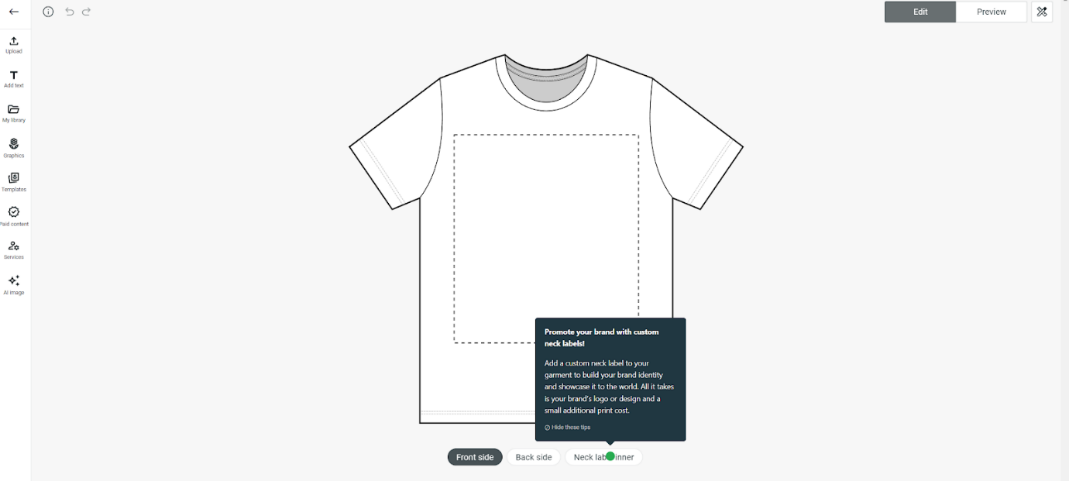
Once you add each product to your store, Printful will receive any orders placed by your customers.
This allows the in-house team to create your product, package it (according to your instructions) and ship it directly to your customer.
You just pay for the price of producing and shipping your product, after your customer has already paid you.
How Printify Works

Similarly, you can sign up with Printify for free, and connect your POD platform to a range of storefronts and ecommerce websites.
Alternatively, if you don’t have your own storefront, you’ll be able to create a free “pop-up” store, which allows you to sell items through a custom link.
Printify’s design tools are just as simple and powerful as Printful’s, although you do get the added bonus of a generative AI image generator that can create unique images based on text prompts.
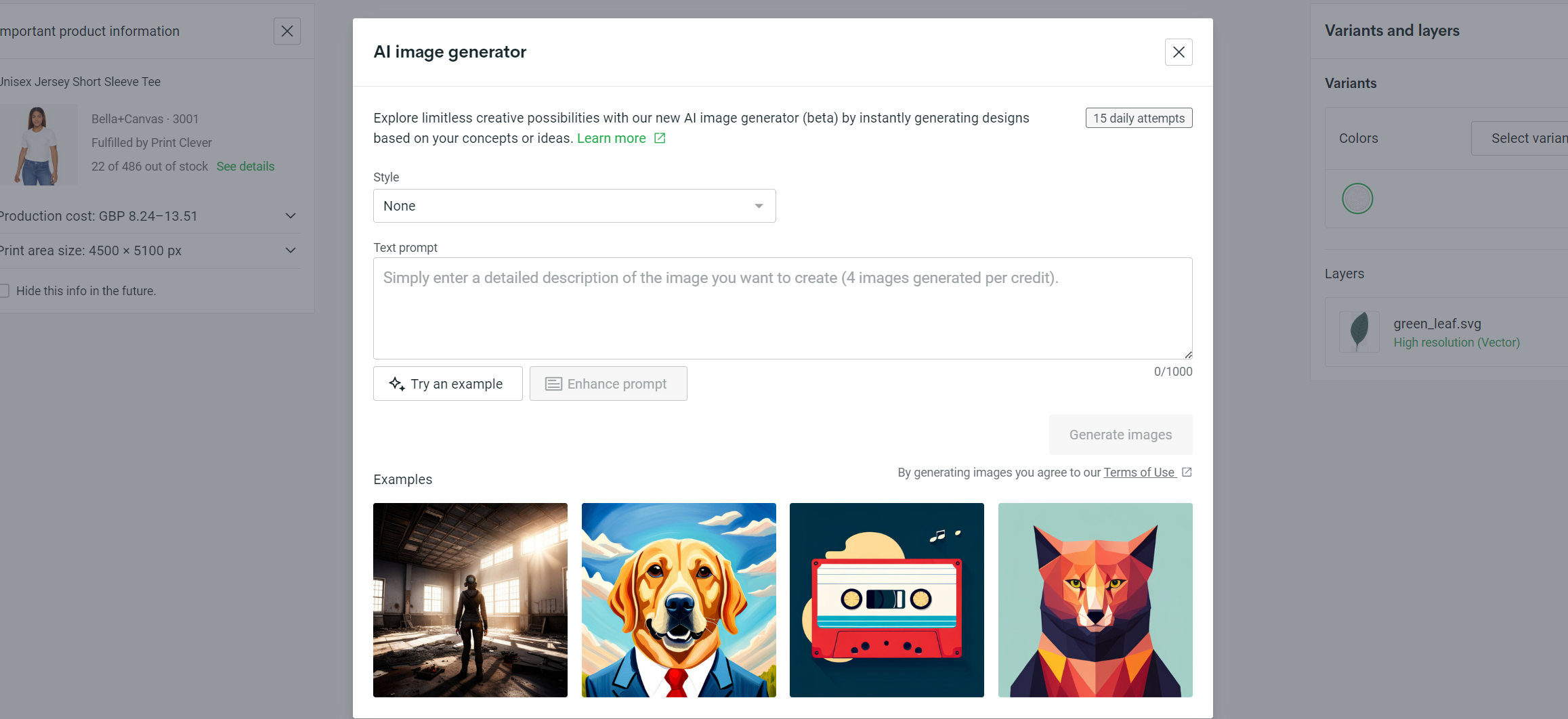
The main way Printful and Printify differ is that you’ll need to choose from a range of partner manufacturers for your products in advance.
Printify doesn’t produce items in-house, it allows you to pick the vendor that’s closest to your customer, and best for your budget.
On the one hand, this does mean you have more freedom to choose the right partners to work with, but as I mentioned above, it can mean that pricing, print quality, and shipping costs vary drastically.
Designing Products in Printful and Printify
One thing to note is that creating custom products in both Printify and Printful is very straightforward. Although I did have a little more fun using Printify’s generative AI image generator.
Both tools allow you to upload JPEG and PNG files, although you also get the option for SVG files in Printify, which is a nice touch.
However, Printful does allow you to upload larger images, up to 200MB compared to Printify’s 100MB.
Printful also offers access to over 700 different fonts (compared to Printify’s 350).
Plus, you can access high-quality stock photos in both platforms, although Printify comes with around 3.5 million images (via Shutterstock), while Printful gives you about 80 million images (via Getty).
Both platforms have their own drag-and-drop editing experience, and both come with background removal tools, although I found Printful’s to be a little more advanced.
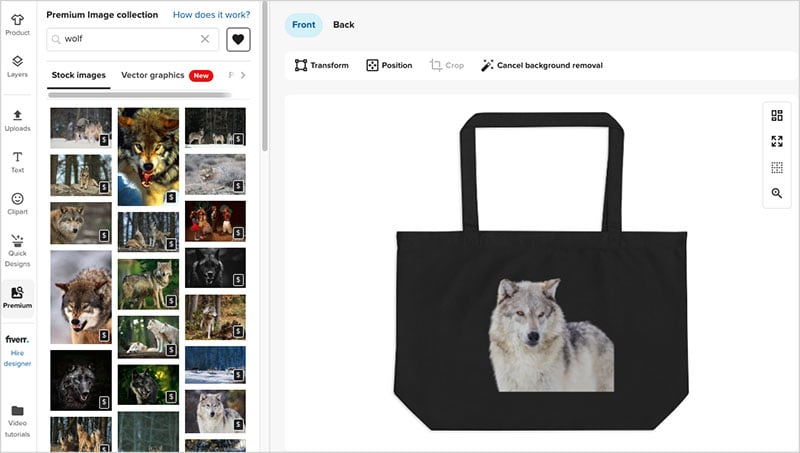
Both platforms also give you some free graphics you can add to your products. Printify gives you over 200 graphics, while Printful has more than 3,000 to browse through.
Notably, both companies also allow you to create comprehensive mockups, with lifestyle images to make your items really stand out.
Printful gives you more than 2,500 scenes to choose from, while Printify only gives you a handful of options for changing backgrounds and designs.

Each platform can also help you to generate product descriptions, by giving you basic “templates” you can edit for your own website.
However neither option has a generative AI option for creating full product descriptions (yet).
With all that in mind, I’d say that both solutions are excellent for creating products (and mockups). However, if you’re looking for a more advanced experience, Printful is definitely the better choice.
Printful vs Printify: Ease of Use and Core Features
When it comes to user-friendliness, I couldn’t see much difference between Printful and Printify. Even the interfaces you’ll use for both platforms are very similar.
They both give you all the key tools you need to create products, integrate with sales platforms, and manage your orders.
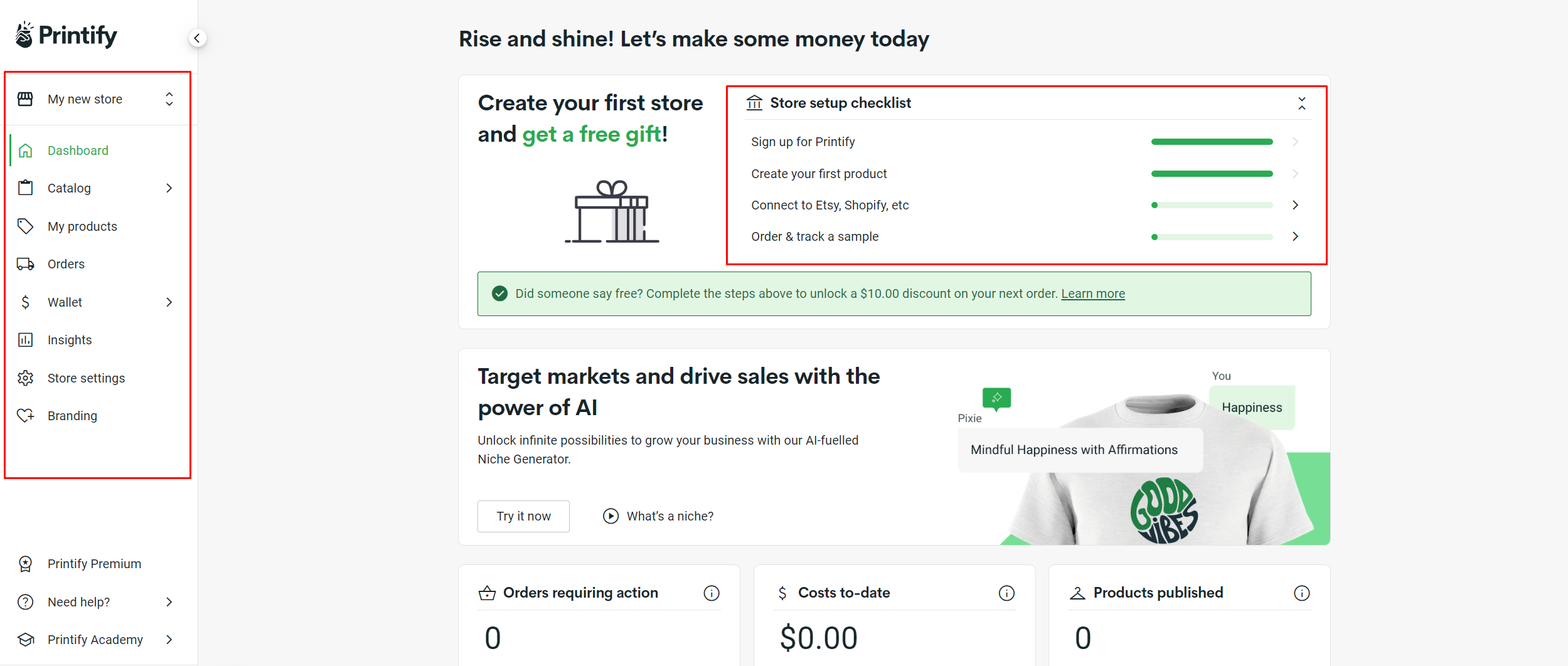
Printify give you a streamlined dashboard where you can check out new features, and see crucial metrics, like which orders are pending, and how much you’ve spent to date.
You also get a handy “store setup checklist”, as a beginner, and a free gift when you get started.
Plus, there’s a handy menu on the left-hand side where you can check out your insights, store settings, catalog, orders, Printify wallet, and more.
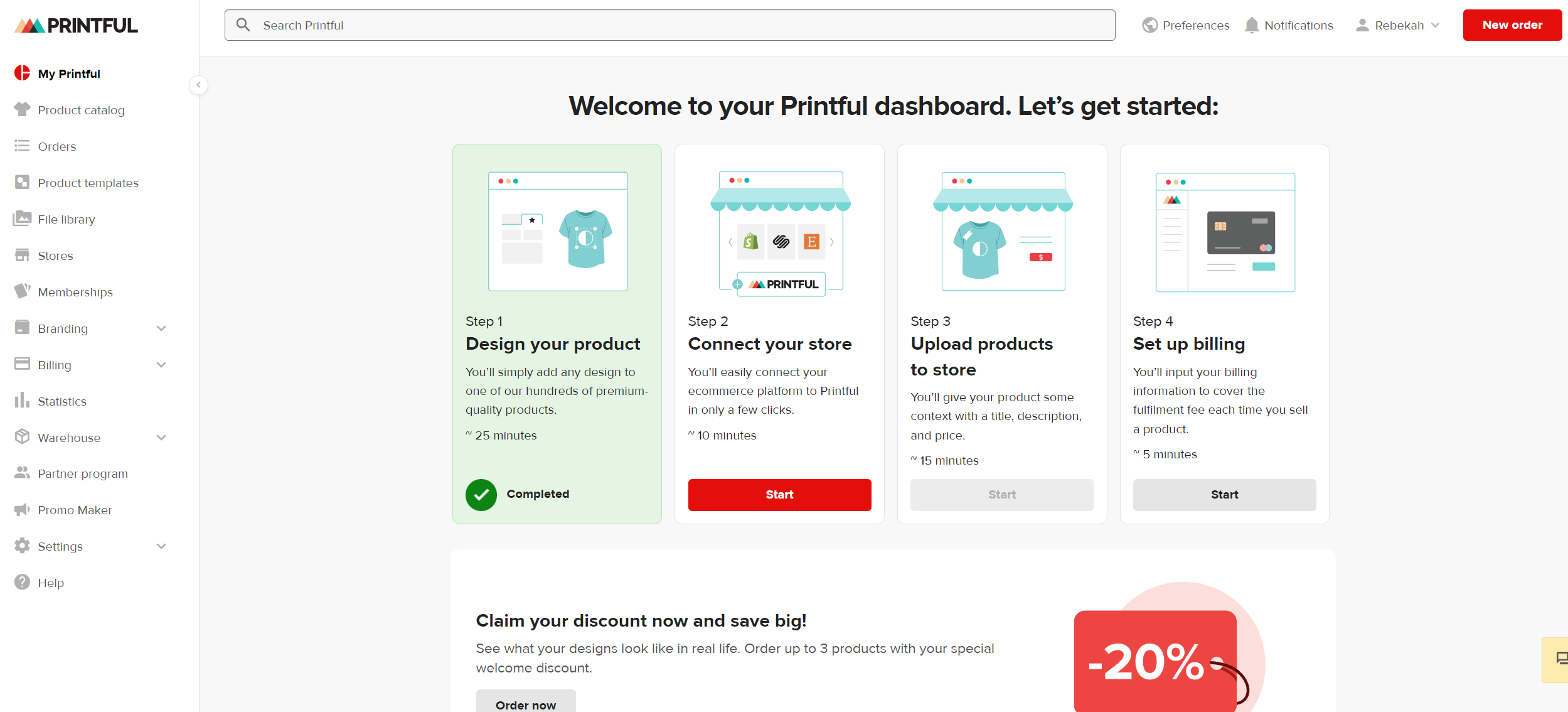
Similarly, Printful has it’s own left-hand side menu bar, with a few more features than Printify. You’ll be able to set up memberships, create a file library, explore warehousing options, and even leverage a promo maker for advertising.
There’s also a handy “checklist” for getting started, although it looks a little different to Printify’s checklist.
After exploring the features of both Printify and Printful, I discovered there are a few areas where both platforms have an edge.
Standout Features of Printful
- More assets and free tools for your design process
- Warehousing options, for bulk selling
- Comprehensive file libraries and product templates
- More comprehensive settings for your account
- Powerful branding capabilities, and pre-sets
- Promo maker for advertising purposes
Standout Features of Printify
- Generative AI image creation tools
- AI-fuelled niche generator for boosting sales
- Printify wallet with exclusive rewards
- Vendor ratings to help you choose the right partner
- Pop-up store generator (if you don’t have a storefront)
- Instant access to Printify Academy for guidance (From the dashboard)
Printify vs Printful: Product Range and Quality
Compared to a lot of the POD platforms I’ve reviewed in the past, both Printful and Printify excel at offering access to a wide range of items.
Both companies give you plenty of categories to choose from, including men’s clothing, women’s clothing, kid’s clothing, accessories, and home décor.

However, Printify offers more than double the number of unique products as Printful (900+ compared to Printful’s 400+).
It also offers unique items that you can’t find on most alternative platforms, like food, health, and beauty products.
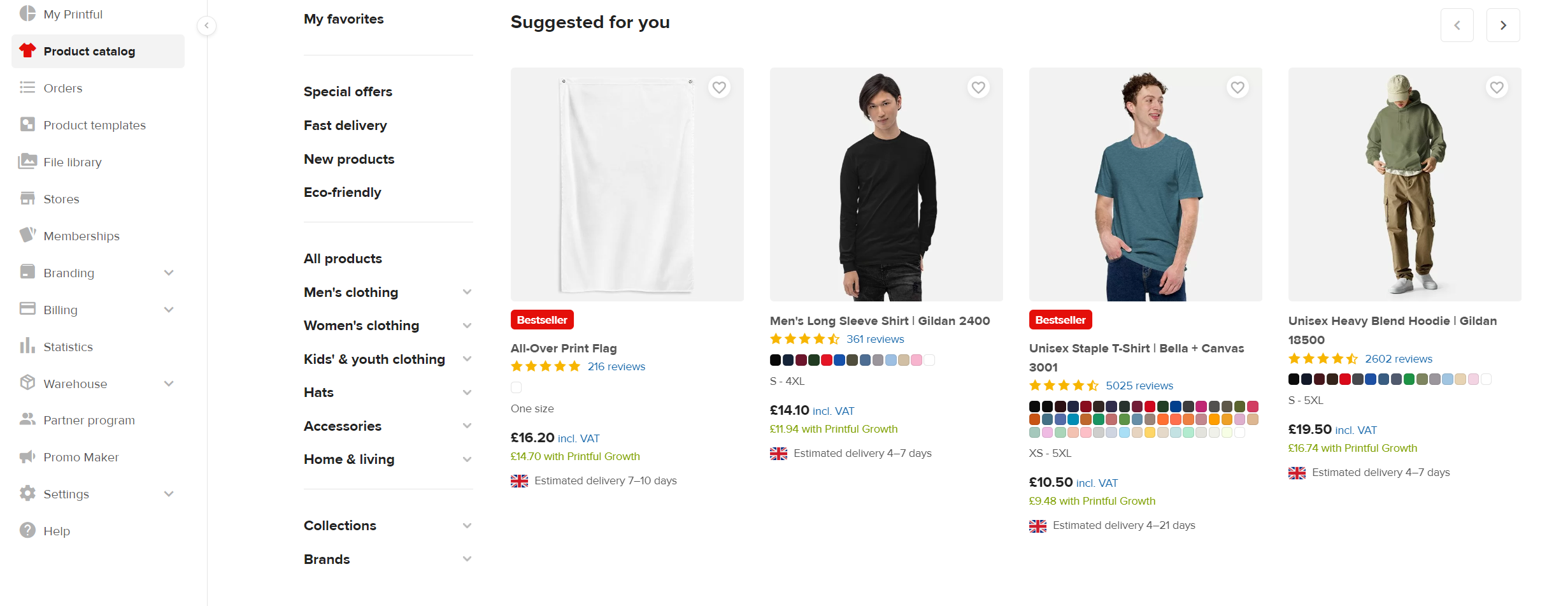
Printful’s product collection is still excellent, however, and it does make it easy to find products local to your customers, if you’re looking for quicker delivery speeds.
Plus, it’s worth noting both companies offer a range of eco-friendly and sustainable items, which I think is crucial in today’s market. There are items made with organic cotton, vegan-friendly materials, and even recycled materials.
Another point I want to mention is that Printful offers a broader selection of ways to brand your products.
With Printify, you can add inside neck labels or sleeve labels to clothing, depending on the supplier you choose.
Printful, on the other hand, gives you outside labels, and more options across their full product catalog. There’s even the option to send Printful packaging and inserts to use in every order.
Plus, Printful allows your customers to actually personalize products themselves, through its integration with different ecommerce platforms. This isn’t an option with Printify.
Print and Product Quality
In terms of print and product quality, both Printify and Printful offer a similar range of printing techniques, such as DTG printing, sublimation printing, and all-over printing.
There’s also support for digital printing, UV printing, and embroidery on some products.
Testing product quality can be a little complicated, but both platforms do have a good reputation for delivering excellent results.
The issue is that Printify connects you with a huge range of vendors and manufacturers, so you never know for sure if the quality is going to be consistent.
Although you can check the ratings of print providers, the user reviews I’ve read suggest that some vendors aren’t as reliable as others.
Printful, on the other hand, is very transparent with how amazing it’s print quality is. In fact, only 0.24% of all orders are ever returned to the platform.
Printful also has a slight edge when it comes to ordering samples to test your product quality.
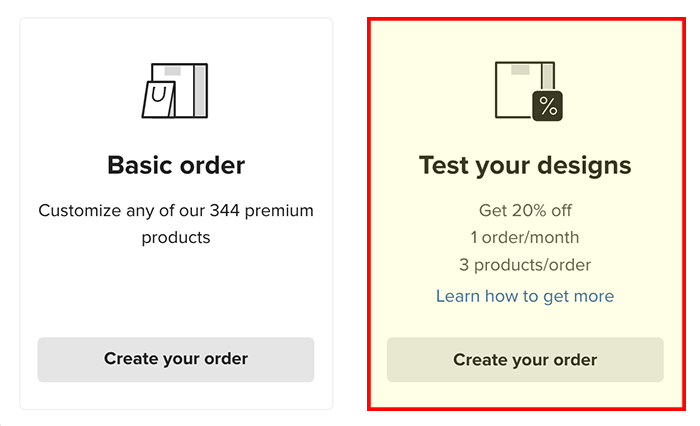
With Printful, you get 20% off your sample orders, if you want to test your design. You can make up to one “sample” order a month, and purchase up to 3 products.
However, Printify charges you the standard price for samples, which can vary based on the supplier you choose.
Integrations with Marketplaces and Ecommerce Platforms
Printful comes out on top again in regard to integration options. That’s not to say you don’t get a range of sales channels to choose from with Printify, however.
With Printify, you can integrate with:
- Shopify
- Etsy
- WooCommerce
- Squarespace
- Wix
- Prestashop
- BigCommerce
- Walmart
- Ebay
- TikTok
Printful, on the other hand, has more than double the integration options. The full list of integrations available for Printful includes:
- Etsy
- Ecwid
- Shopify
- WooCommerce
- Wix
- BigCommerce
- Squarespace
- Prestashop
- Square
- Walmart
- Amazon
- Ebay
- TikTok
- Weebly
- BigCartel
- Adobe Commerce
- Gumroad
- Storenvy
- Shipstation
- Launch Cart
- Shift4Shop

Notably, Printify does have a direct integration with Walmart, which is great for US sellers, but you won’t be able to instantly integrate your store with Amazon (although I have found some workarounds to help with this).
Of course, Printify also offers its free pop-up store generator, which means if you don’t have an existing storefront, you can still sell custom products through a unique link.
Just don’t expect your store to have all the robust feature you’d get from a platform like Shopify. The pop-up stores are very basic, and in my opinion, not extremely scalable.
Printful vs Printify Pricing
In the past, Printify was the cheaper option for creators with a limited budget, but that’s not the case anymore.
Both tools now allow you to get started for free, and they both have reasonably affordable products on offer (though Printful’s can be slightly more expensive).
Printify Pricing

First, Printify offers merchants three “plans”, they can experiment with when growing their store. All of these plans (including the free option) will allow you to create an unlimited number of products, and access all of the integration options and design tools you like.
However, for scaling companies, the paid plans ($29 per month for Premium and custom pricing for Enterprise) offer more benefits.
For instance, on the Premium plan, you’ll be able to create up to 10 products per account, and get a 20% discount on all items. You can also use “Printify Connect”, which means Printify will handle customer support for you.
The Enterprise plan comes with custom API integration, a dedicated account manager, additional discounts on all products, and more features.
Printful Pricing
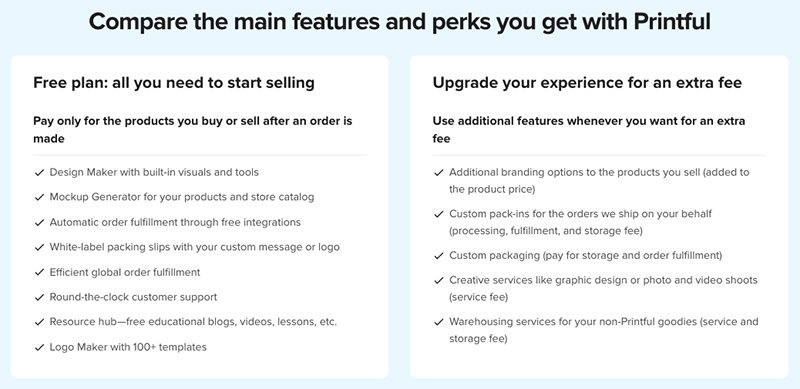
Like Printify, Printful allows creators to get started without paying any monthly fees. The free plan offers comprehensive access to all of Printful’s products, design tools, and integrations.
However, there are a lot of “add-ons” available from Printful that you might pay extra for.
For instance:
- Branded packaging insert storage fees range from $0.80 to $1.65 per cubic foot.
- Branded insert picking fees start at $0.50 per order.
- Warehouse storage fees range from $0.80 to $1.60 per cubic foot.
- Custom labels for garments start at $2.50 per order.
- Product photography and apparel design services (via Fiverr) range from $10 to $350 per product and requirement.
Printful also offers “membership” options, which are free depending on how much revenue you earn in a 12 month period.
You can apply for the “Growth” membership” when you earn $12k a year, and the “Business” membership when you earn $60k a year.
However, you’ll also be able to buy a Growth membership for an extra $24.99 per month.
These memberships come with additional benefits, such as:
- Printful Growth: 20% off DTG products, 7% branding discounts, 30% off other products, unlimited stores for each account and product transfer support.
- Printful Business: 22% off DTG, 33% off other products, branding discounts of 9%, free embroidered product digitization, priority support, and large front prints for some products.
Product and Shipping Prices
Both Printful and Printify do offer discounts that can help you keep product costs low. Printful’s are offered via its membership programs, while Printify gives discounts to paying subscribers.
When it comes to product and shipping pricing, it’s hard to get a clear view of what you can expect to pay with Printify.
Each of the suppliers working with Printify have their own pricing for similar products, so you’ll need to shop around for the best cost.
Printful’s products can be slightly more expensive than some of the options offered by Printify vendors, but you do get a more consistent level of quality.
For shipping both companies partner with reputable carriers like DHL, UPS, FedEx, and DPD. Plus, they both give you the option to display real-time shipping rates on your product pages.
However, with Printful, your prices are likely to remain the same for both products and shipping, as the orders are produced in-house.
With Printify, you need to spend a lot more time shopping around for the best balance between product quality, and product and shipping costs.
Customer Support and Service
I’ve already noted that Printful and Printify have a lot of similarities, and that’s true again in their approach to customer support.
Both companies allow you to reach out to the company in two primary ways: email and live chat. I found that the response times from both companies was relatively fast.
However, Printify can occasionally be overwhelmed with too many requests (during busier periods), which means you might need to wait a little longer.
Additionally, both tools offer fantastic self-help resources on their websites. Printful has a comprehensive help center available in different languages, where you can find FAQs, guides, articles, and more related to everything you might need to know.
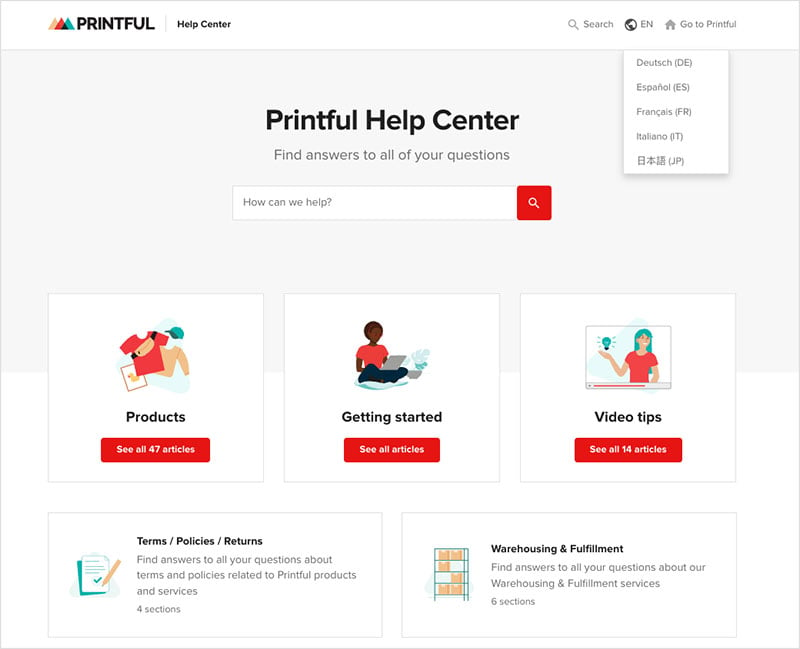
I actually found this help center to be a lot more valuable than Printify’s own solution, simply because it included a lot more in-depth content.
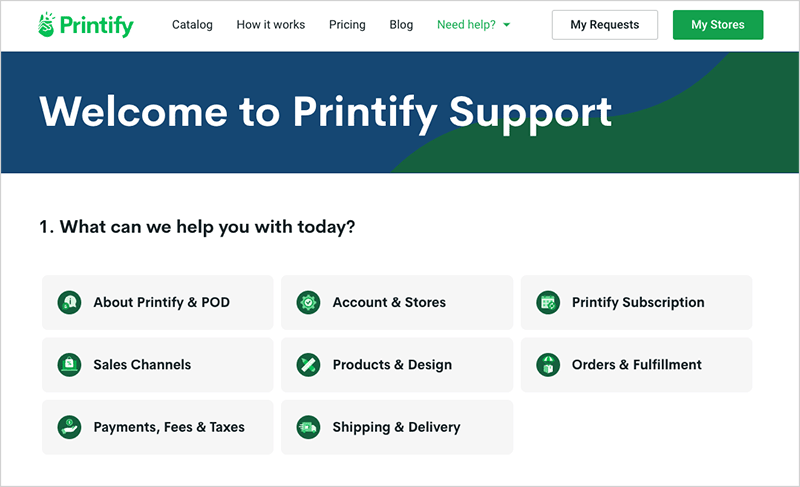
Printify’s own help center is still decent, and it has a great blog which I’d definitely recommend checking out if you’re just getting started with print on demand.
Both companies also offer free courses and webinars to teach beginners how to get started with their new ventures.
Plus, if you use Printful’s “Academy” courses, you can receive points that you can exchange for free products, discounts, and sample orders.
Printful vs Printify: The Final Verdict
There’s a lot to love about both Printful and Printify. Throughout my reviews of both platforms, however, I found that Printful had a winning edge a lot more often.
Printful is the stronger choice if you’re looking for great product quality, powerful design tools, more branding options, and a wider range of integrations.
However, Printify has it’s unique benefits too. For instance, with Printify, you get the awesome generative AI image creator, as well as access to a wider selection of products, and vendors.
You’ll also maintain full control over which printing companies you want to use for your items.
Plus, Printify’s pop-up store generator is useful for beginners who don’t have their own storefront already.





Comments 0 Responses